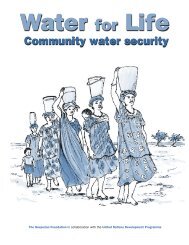A Sourcebook - UN-Water
A Sourcebook - UN-Water
A Sourcebook - UN-Water
You also want an ePaper? Increase the reach of your titles
YUMPU automatically turns print PDFs into web optimized ePapers that Google loves.
4.3 Informal Service Provision<br />
In most developing countries, formal service providers do not serve the whole population, even within<br />
urban areas. Where this is the case, the remainder of the population—those who are “unserved”<br />
by the utility—must get their water elsewhere. The alternatives are either self-provision (for example<br />
through collecting rainwater or water from streams), or private, informal water vendors. Informal providers<br />
can include water tankers, water carriers, or privately provided standpipes. These alternatives<br />
are, in some cases, also used by connected customers to complement unsatisfactory service by the<br />
formal utility.<br />
The cost of informal provision is, in general, higher than well organized formal provision through a<br />
piped network (at least in densely populated areas). A high level of informal supply therefore indicates,<br />
at best, failure on the part of the formal service provision system. This failure may have its roots in<br />
poor governance.<br />
High levels of informal provision may also indicate something much more pernicious—a deliberate<br />
sabotage of the formal system by government officials who can profit from involvement in the informal<br />
system. In some cases, those with power over the formal utility engineer its failure, in order to create<br />
scarcity that informal service providers can fill.<br />
These informal service providers often use public resources. For instance, private water tankers may<br />
get free or low cost water from the public network. Public officials may cooperate with gangs to cartelize<br />
the informal service provision. This creates a supply of rents, part of which is passed back to the<br />
public officials who sabotaged the public water supply, encouraging a continuation of this arrangement.<br />
Plummer (2007) summarizes the relationship between informal service provision and corruption in a<br />
case study from an urban slum in Latin America:<br />
In a steep hillside squatter settlement in Latin America, poor households have waited for utility<br />
water for decades. With little confidence that the local council would extend the network,<br />
most communities opted for water provided by informal service providers, who stole or bought<br />
the utility water and delivered it in tankers. The price varies substantially as the providers were<br />
susceptible to the demands of the municipal water officials, paying them for the water they<br />
used and periodic silence payments. When one of these officials came to the squatter settlement<br />
and saw a huge new market, he decided to begin delivering water to the settlement<br />
himself—moonlighting at night using a utility tanker. He sold water at the same price as the local<br />
private provider, and in developing such a lucrative personal business, he made no further<br />
recommendations that the network be extended. 7<br />
Where informal providers supply a substantial part of the market, and where this situation appears to<br />
be entrenched, sector practitioners need to be mindful that corruption may be part of the cause. Indicators<br />
of corruption based on informal provision include:<br />
• High levels of informal service provision. Indirect evidence of this is provided by measures of the<br />
utility’s water and sanitation coverage (see Table 4.1). If coverage is low, it is probable that informal<br />
providers are filling this gap<br />
• Cartelization of informal service provision. For example the following factors may indicate<br />
cartelization:<br />
7<br />
Plummer, J. (2007). “Making Anti-Corruption Approaches Work for the Poor: Issues for Consideration in the Development<br />
of Pro-poor Anti-corruption Strategies in <strong>Water</strong> Services and Irrigation”. Swedish <strong>Water</strong> House Report No. 22<br />
26
















